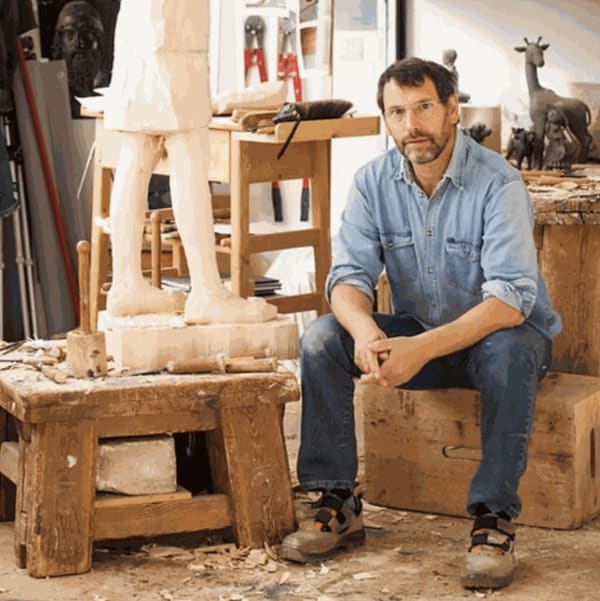Willy Verginer Italian, b. 1957
-
 "Komm Lieber Mai Und Mache....", 2024
"Komm Lieber Mai Und Mache....", 2024 -
 Ragazza sole, 2023
Ragazza sole, 2023 -
 "Komm Lieber Mai Und Mache...." Commission inspired by "Da Ramo a Ramo", 2023
"Komm Lieber Mai Und Mache...." Commission inspired by "Da Ramo a Ramo", 2023 -
 Quattro Zoccoli In Paradiso (blue), 2023
Quattro Zoccoli In Paradiso (blue), 2023 -
 Una Storia Vera (girl), 2023
Una Storia Vera (girl), 2023 -
 Ragazza Luna, 2023
Ragazza Luna, 2023 -
 Il Gioco Infinito, 2021
Il Gioco Infinito, 2021 -
 Moongirl, 2022
Moongirl, 2022 -
 Our head is round in order to enable our thoughts to change direction, 2017 Sold
Our head is round in order to enable our thoughts to change direction, 2017 Sold -
 Una Storia Vera (girl), 2023 Sold
Una Storia Vera (girl), 2023 Sold -
 Sungirl, 2022 Sold
Sungirl, 2022 Sold -
 Le Petit Prince, 2021 Sold
Le Petit Prince, 2021 Sold -
 On the other side, 2017 Sold
On the other side, 2017 Sold -
 Acqua Alta Figure 2, 2019 Sold
Acqua Alta Figure 2, 2019 Sold -
 White Box, 2020 Sold
White Box, 2020 Sold -
 Ecological Balance, 2023 Sold
Ecological Balance, 2023 Sold
-

Group Exhibition | Toronto
Contemplation 29 Jul - 8 Sep 2024This summer, Gallery LeRoyer | Toronto inviting the viewers to immerse themselves in transformative essence of art. Featuring a curated selection of works by Zhuang Hong-Yi, Lu Luo, Rogelio Manzo,...Read more -

Art Miami | BOOTH AM510
ART FAIR 29 Nov - 4 Dec 2022Read more -

“Rayuela” Willy Verginer
FOCUS | GLRTO 1 - 31 Oct 2022Read more -

GROUP EXHIBITION
EXHIBITION | GLRTO 1 - 30 Sep 2022Read more -

Art Miami
Miami | Art fair 30 Nov - 5 Dec 2021Read more -

Art Toronto
Toronto | Art fair 1 - 31 Oct 2021Read more -

Galerie LeRoyer | Art Miami and CONTEXT Art Miami
Virtual Exhibition 1 - 31 Dec 2020Read more -

Willy Verginer
Eyes Wide Shut | GLR24 1 - 30 Jun 2019Read more -

Willy Verginer
Human Nature 1 - 30 Sep 2014Read more
-

The Lost Garden of Willy Verginer
Willy Verginer July 1, 2022The poetics of Willy Verginer, one of the most important sculptors in Italy and abroad, and the theme of the Garden of Eden in the...Read more -

Willy Verginer exhibited in China
Willy Verginer January 1, 2022Willy Verginer is part of a group exhibition in Zheijang Art Museum presented with the collaboration of the Italian Cultural Institute of Shanghai and entitled...Read more -

Bold paint bands bisect playful wood sculptures
Willy Verginer March 1, 2021Clusters of wooden spheres bubble up the fingertips and bodies of the children in Willy Verginer ’s poetic sculptures. The Italian artist (previously ) contrasts...Read more -

Eyes wide shut
Willy Verginer July 1, 2019The working technique adopted by Willy Verginer reveals his approach, both figurative and conceptual. His sculptures are made up of several blocks of wood, naturally...Read more -

7 exhibitions to see this summer
Willy Verginer June 1, 2019Dive into the world of Italian artist Willy Verginer as he presents his latest series of hyperrealistic wooden sculptures at Galerie LeRoyer in Old Montreal....Read more -

Nature in Art
Willy Verginer May 1, 2019Willy Verginer'sculptures are currently featured in the exhibition 'Nature in Art' at the Mocak Museum of Contemporary Art in Krakow until the end of September....Read more -

Wooden Wonders: The surreal sculptures
Willy Verginer June 1, 2018Yes, you're right: these surreal sculptures do look like they've been carved from stone or moulded from some kind of plaster. But incredibly, they've all...Read more

































